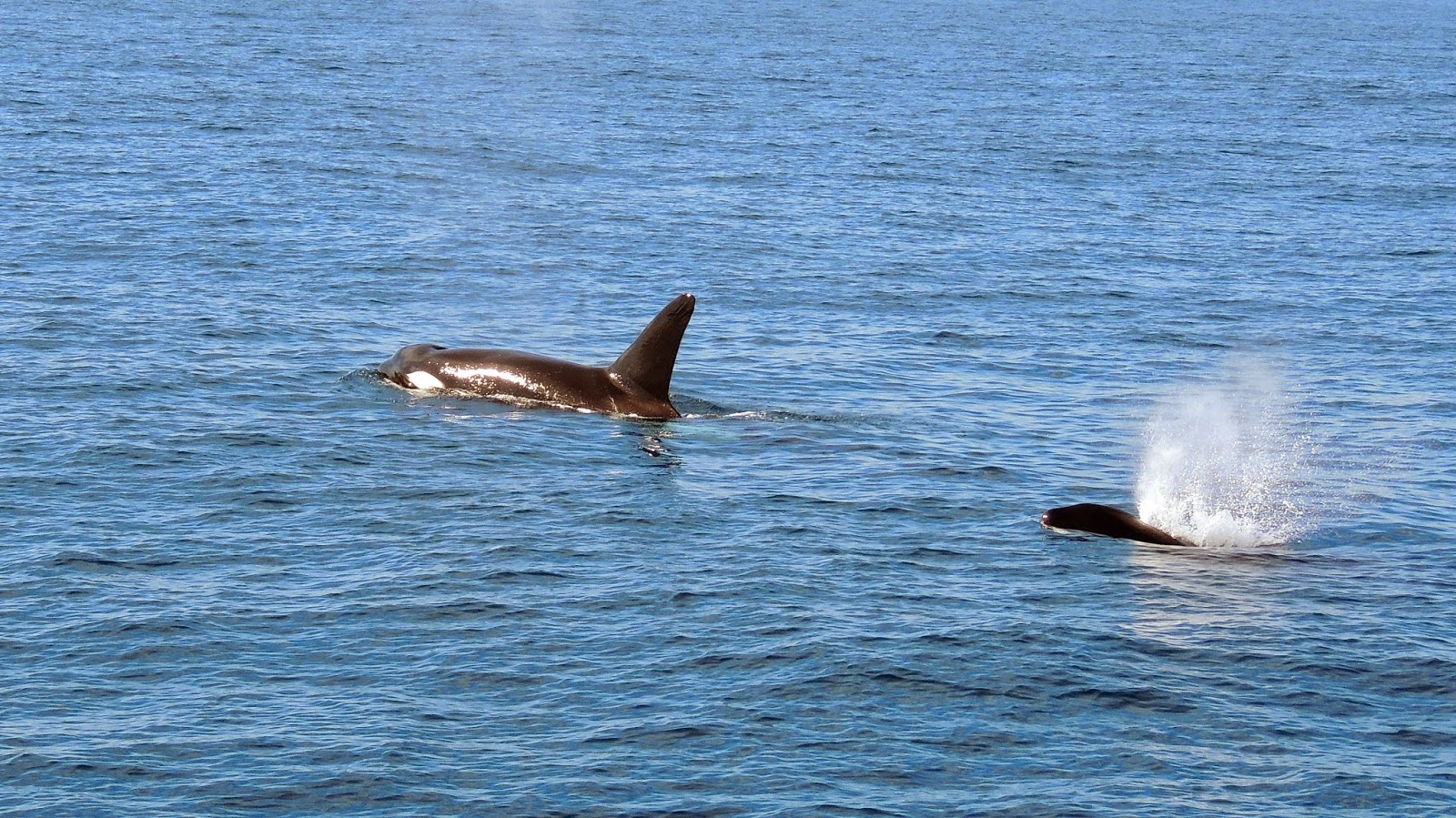On 25 November 2013 we headed off from Mirissa hoping to see Blue Whales but in the GPS position some had been seen the day before there were two Orcas, or in old money, Killer Whales. You can see them on the video footage I took (below or directly on YouTube) along with the Blue Whales.
In looking for further information on orcas in Sri Lankan waters, I came across the brilliant Orca Project Sri Lanka (OPSL) which, to quote: is the first citizen-science project centred on studying orcas (Killer Whales) sighted off Sri Lanka. On scrolling down the posts I found that our two orcas were known to them. They were OM001 ‘King’ and OK008 ‘Arya’ and have been seen off Mirissa in 2008, 2010, 2011, 2012, 2013 and 2014. After we saw them on 25 November 2013, they appeared again on 7 January, 12 April and 7 June 2014.
 |
| The two orcas. AJP Photograph |
Then things got even more interesting. A fellow traveller on the Naturetrek tour whale-watching extension sent us a still photograph which showed the orcas pushing what appeared to be some sort of dolphin with a brownish coloration around the base of a beak. I had missed it on video as I changed positions but could just see the end of the action as I began to film again. Other photographers had sent stills to OPSL and they in turn asked experts on marine mammals. Here is an extract from OPSL’s post of 19 December 2013 (the photographs are shown there):
…OPSL in collaboration with Josh McInnes of the The Transient Killer Whale Research Project are currently writing a small paper on a very exciting finding. When OM001 and OK008 visited Mirissa on the 25th of November, they decided to chow down on the local marine-life...so what's on their menu? Turns out they like Beaked whale, deep diving and little-understood cetaceans of the Ziphiidae family…Observation details include the orcas feeding on an unidentified object. In two of the images, a beak or rostrum can be seen with a patchy brown/green colouration to the surrounding skin. OPSL contacted Josh McInnes, who specializes in the study of mammal-eating (transient) killer whales of the Pacific Northwest, to offer his opinion on the ID. After looking at the photos, Josh concluded that the beak shape and brown/green colouration (caused by diatoms) appears to be consistent with that of a Blainville’s beaked whale Mesoplodon densirostris.
I had seen a report from the BBC which described research on the stealth mode Blainville’s Beaked Whale adopts when it is comparatively near the surface. In the depths the beaked whales are rather vociferous but on rising towards the surface for air sonar silence reigns. With orcas around I can see why that is a good strategy.
Links to this and other work on the fascinating world of ziphid cetaceans, written by the lead worker, Natacha Aguilar Soto, of La Laguna University in the Canary Islands, are here. A video showing their work on beaked whales is here.
The Smithsonian Institution has a Beaked Whale Identification Guide showing photographs of dead specimens. Another possibility, purely on the basis of one specimen stranded on Sri Lanka is Mesoplodon ginkgodens, a species known only from a few dozen specimens. It would be interesting to hear whether the marine mammal experts can eliminate this one. From a size comparison with the orcas, my impression, and it is only an impression, is that the beaked whale killed must have been not fully grown (and female?) when some of the clearer differences between the two species might not be evident. However, looking at the photographs in the Smithsonian collection, I do see where the experts are coming from. Whatever, the time must be ripe for some hydrophonics in the deep waters of Dondra Head even though the sound of ships’ engines will be a constant feature. Has anybody tried to pick up the sounds of beaked whales there yet?
NOTE ADDED 12 APRIL 2022
Well we did have a photograph of the orca battering the beaked whale. I was looking through AJP's still photographs and noticed it, taken what must have been seconds from the ones taken by a member of our party. The rostrum is clearly recognisable:



No comments:
Post a Comment